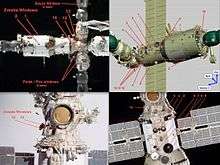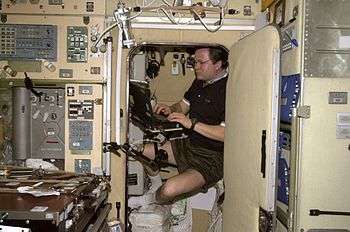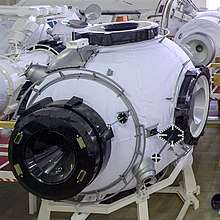Russian Orbital Segment
The Russian Orbital Segment (ROS) is the name given to the components of the International Space Station (ISS) constructed in Russia and operated by the Russian Federal Space Agency (Roscosmos). The ROS handles Guidance, Navigation, and Control for the entire Station.



Current composition
The segment currently consists of five modules, which together essentially comprise the base configuration of the cancelled Russian space station Mir-2.[2] The segment is controlled directly from Roskosmos's Mission Control Center in Moscow. The five modules are (in order of launch):
The first module, Zarya, otherwise known as the Functional Cargo Block or FGB, was the first component of the ISS to be launched, and provided the early station configuration with electrical power, storage, propulsion, and navigation guidance, until a short time after the Russian service module Zvezda docked and was transferred control. Zvezda contains the ESA built DMS-R Data Management System.[3] Now primarily used for storage, Zarya provides ports for Soyuz spacecraft, Progress (spacecraft) and the European ATV to dock to the station. Ships boosting the station's orbit dock to the aft port (the rear port according to the station's normal orientation and direction of travel). The FGB is a descendant of the TKS spacecraft designed for the Russian Salyut program. 5.4 tons of propellant fuel can be stored and transferred automatically to and from ships docked. Zarya was originally intended as a module for the Russian Mir space station, but was not flown as of the end of the Mir-1 program. Developed by Russia and the former Soviet Union, construction of Zarya was funded by the United States and NASA,[4] and Zarya remains a US-owned module.[5]
The second module, Zvezda, is the station's Service Module - it provides a living environment for the crew, contains the ISS's main engine system, and provides a docking port for Soyuz, Progress and Automated Transfer Vehicle spacecraft.[6]
The third module, Pirs, functions as the ROS's airlock, storing EVA spacesuits and providing the equipment necessary for cosmonauts to exit the space station. It also serves as a docking compartment for Soyuz and Progress spacecraft.[7]
The fourth module, Poisk, is similar to Pirs. Redundancy in airlocks allows one airlock to be repaired internally and externally whilst crew use the other airlock to exit and re-enter the station.
The fifth module, Rassvet, is primarily used for cargo storage and as a docking port for visiting spacecraft.
Future modules
Nauka
Nauka (Russian: Нау́ка; lit. Science), also known as the Multipurpose Laboratory Module (MLM) or FGB-2, (Russian: Многофункциональный лабораторный модуль, or МЛМ), is the major Russian laboratory module which will take the place of Pirs. In October 2011, it was reported that Nauka was expected to be launched in December 2013.[8] Prior to the arrival of the MLM, a Progress robotic spacecraft will dock with Pirs, depart with that module, and both will be discarded and burn up in the atmosphere. Nauka will then use its own engines to attach itself to the ROS. This module was intended to separate from the ISS before de-orbit with support modules and become the OPSEK space station, in 2017 Roscosmos announced that it had no further intention to separate the ROS from the ISS in the future, and will continue working with its partners. It contains an additional set of life support systems and orientation control. Power provided by its solar arrays will mean the ROS no longer relies on power from the USOS main arrays. The launch date has now slipped for many years, the next possible date is in November 2019. Nauka's mission has changed over time. During the mid-1990s, it was intended as a backup for the FGB, and later as a universal docking module (UDM). Its docking ports will be able to support automatic docking of both space craft, additional modules and fuel transfer.
On January 23, 2020, TASS reported that the roll out was postponed until the end of March to replace valves on Nauka's fuel tanks.[9] On February 4, 2020 Dmitry Rogozin said Nauka required more testing because the warranty had expired and testing could only be done in Moscow instead of Kazakhstan delaying launch to January 2021. Testing is on going and should be completed by May.[10] On February 21, 2020 construction of the Proton rocket was completed and the stages were shipped to Baikonur.[11] On April 2, 2020, TASS reported that repairs to the valves were complete but the module's systems had yet to be tested before shipment to Baikonur, which would move the roll out to the end of May. Due to concerns over coronavirus disease 2019, work has been suspended until April 15th, but systems testing will be performed by a skeleton crew until work resumes.[12]
Oka-T-MKS
The Oka-T-MKS was a planned companion module to the ISS. Reported as of December 2012 to be under construction, its development has been significantly delayed. The module would be free-floating most of the time as an autonomous orbital space laboratory for the conduction of experiments, and dock with the ISS for experiment maintenance about every 180 days. The Oka-T-MKS space laboratory was contracted to Energia by Roscosmos in 2012. Originally projected for a 2015 launch date, this has been pushed back indefinitely and some evidence suggests that, unable to locate significant development partnerships, its development has been abandoned.[13][14]
Proposed modules
On June 17, 2009, the Russian Federal Space Agency (Roskosmos) presented to NASA and the other ISS partners a proposal to add additional modules to the Russian segment to ensure its viability past 2016 or even 2020. To this end, a Nodal Module that would be attached to the nadir docking port of Nauka (MLM) would facilitate the attachment of two additional, larger modules that would be capable of providing an independent power source to the Russian segment should current plans to deorbit the US segment of the ISS after 2016 move forward. As proposed, the Nodal Module would be launched during 2013 by a Soyuz launcher in a similar fashion to how the Pirs and Poisk MRM-2 modules were lifted to orbit. The two larger modules, nominally referred to as Scientific and Power Producing Modules 1 and 2, would be lifted to orbit via Proton launchers in 2014 and 2015, respectively. These two modules would be attached to the port and starboard sides of the Nodal Module, leaving its aft docking port accessible for possible future expandability and its nadir port accessible for docking by Soyuz or Progress spacecraft. Because of the proximity of the Nodal Module to the planned attachment point of MRM-1 on the nadir docking port of Zarya FGB to facilitate docking of Soyuz and Progress spacecraft, the module's forward-facing port will be unusable. As of January 2010, neither Roskosmos nor NASA have provided further details of these modules or verification that they have been officially funded by the Russian government or added to the ISS launch manifest schedule.[15][16][17]
Prichal Node Module

Nodal module Prichal also known as Uzlovoy Module or UM (Russian: Узловой Модуль "Причал", Nodal Module Berth)[18] is a Russian spacecraft which will form part of the International Space Station (ISS). Approved in 2011 and scheduled for launch in 2022.[19][20] The node module was intended to serve as the only permanent element of the future OPSEK.[21][22]
See also
- Orbital Piloted Assembly and Experiment Complex - proposed separation of parts of ROS into a separate spacestation
- Scientific research on the ISS
References
- "Mir-2". Encyclopaedia Astronautica. 31 July 2008. Retrieved 2009-01-29.
- "Exercising Control 49 months of DMS-R Operations" (PDF). Esa.int. Retrieved 2016-02-24.
- "Zarya | NASA". Nasa.gov. 1998-11-20. Retrieved 2016-02-24.
- "S.P. Korolev RSC Energia - ISS - ISS Russian Segment". Energia.ru. Retrieved 2016-02-24.
- "Zvezda Service Module". NASA. 14 October 2006. Retrieved 2009-01-29.
- "Pirs Docking Compartment". NASA. 10 May 2006. Retrieved 2009-01-29.
- "New money for the old "Science"" (in Russian). Gazeta.ru. 2011-10-19. Retrieved 1 February 2012.
- https://tass.ru/kosmos/7585127
- https://tass.com/science/1116085
- https://tass.com/science/1122807
- https://tass.com/science/1139385
- "Russia to build autonomous space lab". SpaceDaily. 21 December 2012. Retrieved 22 December 2012.
- https://space.skyrocket.de/doc_sdat/oka-t.htm
- "Novosti Kosmonavtiki article, "Программа развития российского сегмента МКС" (ISS segment development program) [English summary of Russian technical article]". Kosmonavtka.
- "Russia Needs Billions More To Complete It's ISS Segment". Space-Travel.com. 14 April 2008. Retrieved 2009-01-29.
- Sergei Shamsutdinov (July 2008). "Program for Development of the Russian ISS Segment" (in Russian). Novosti Kosmonavtiki. Archived from the original on 6 June 2011. Retrieved 2009-02-15.
- "В РКК "Энергия" утвердили эскиз нового узлового модуля МКС". Roskosmos. Retrieved 30 December 2012.
- Sohail, Daniyal (20 February 2019). "Russia To Install Prichal Node Module On ISS In 2022, One Year Behind Schedule - Glavkosmos". UrduPoint. Retrieved 8 November 2019.
- "Строительство российского сегмента МКС завершится в 2022 году" [Building of the Russian segment of the ISS will be finished in 2022] (in Russian). RIA Novosti. 19 November 2018. Retrieved 20 November 2018.
- S.P. Korolev RSC Energia – News. Energia.ru (13 January 2011). Retrieved 8 October 2011.
- Node Module Archived 3 March 2016 at the Wayback Machine. Russianspaceweb.com. Retrieved 8 October 2011.
External links
- Science Research on ISS Russian Segment - S.P. Korolev RSC Energia
| Preceded by Mir-2 |
Russian Orbital Segment November 1993 - 2015/2024 |
Succeeded by |

